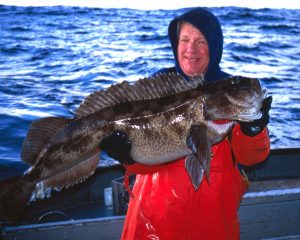Lingcod in Alaska: Are marine reserves an effective tool for conserving stocks of lingcod?
 Stock assessments conducted by the Pacific Fishery Management Council have indicated large population declines for lingcod along the West Coast of North America. This dramatic decline in population has led some fishery managers to suggest the use of marine reserves as a management tool for conservation of lingcod stocks. The efficacy of a marine reserve for lingcod, however, is dependent upon fish site fidelity and rates of movements. We designed a project to surgically implant sonic transmitters in lingcod to evaluate their residence time and movements in an existing marine reserve in Southeast Alaska. The results provided evidence that marine reserves can increase conservation and fishery yield for lingcod stocks.
Stock assessments conducted by the Pacific Fishery Management Council have indicated large population declines for lingcod along the West Coast of North America. This dramatic decline in population has led some fishery managers to suggest the use of marine reserves as a management tool for conservation of lingcod stocks. The efficacy of a marine reserve for lingcod, however, is dependent upon fish site fidelity and rates of movements. We designed a project to surgically implant sonic transmitters in lingcod to evaluate their residence time and movements in an existing marine reserve in Southeast Alaska. The results provided evidence that marine reserves can increase conservation and fishery yield for lingcod stocks.
Starr, R.M., V. O’Connell, S. Ralston, and L. Breaker. 2005. Use of acoustic tags to estimate natural mortality, spillover, and movements of lingcod (Ophiodon elongatus) in a marine reserve. Marine Technology Society Journal. Spring 2005, Vol. 39, No. 1, pp. 19-30.
Starr, R.M., V. O’Connell, and S.Ralston. 2004. Movements of lingcod (Ophiodon elongatus) in southeast Alaska: potential for increased conservation and yield from marine reserves. Canadian Journal of Fisheries and Aquatic Sciences, Vol. 61, No. 7. pp. 1083 -1094.

